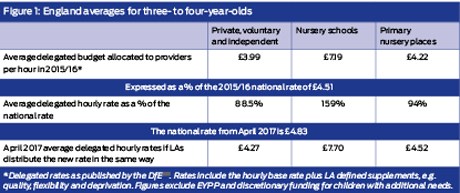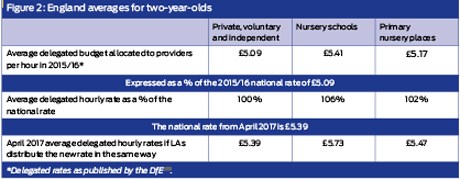Does the 30-hour funding stack up?
Dr Jo Verrill
Monday, December 14, 2015
Following the announcements made in the Chancellor’s Autumn Spending Review, Dr Jo Verrill, managing director of research agency Ceeda, examines how providers will be affected financially

National hourly funding rates of £4.88 for three- to four-year-olds (including Early Years Pupil Premium), £5.39 for two-year-olds and narrower eligibility criteria for the 30-hour offer were among the key announcements in the Government’s Autumn Spending Review.
Much is yet unknown about how the national rates, inclusive of administrative funds retained by local authorities, will translate into monies received by childcare providers in different parts of the country. Consultation commences in the new year on what a National Funding Formula might look like, with plans to introduce an Early Years National Funding Formula from April 2017.
Ceeda has been taking a look at the detail of the announcements and the assumptions underpinning DfE cost-modelling. We share our initial thoughts here.
The hourly rates in context
In this period of uncertainty it is helpful to place the announced rates in context so we can assess the challenges an Early Years Funding Formula will need to tackle. This can be done by looking at current distributions.
Looking first at funding rates for three- and four-year-olds, the DfE has confirmed that the EYPP element of announced rates is approximately £0.05 per hour. When this is deducted, the national rate for three- and four-year-olds will increase from £4.51 to £4.83(1).
Figure one shows how the 2015/16 national funding rate translated into monies paid to different types of provider, based on England averages. It then compares how this would look in April 2017 if local authorities distribute the new rate in the same way.
Assuming local authorities distribute the new rate in the same way as 2015/16 funds have been delegated, private, voluntary and independent providers (PVIs) can expect to receive an average of £4.27 of the £4.83 national hourly rate.

The Pre-school Learning Alliance commissioned Ceeda to produce forecasts of non-domestic PVI delivery costs using data from extensive research in 2014 and factoring in recent and forthcoming statutory pay and pension changes(3). Forecasts for the financial year ending March 2017 indicate breakeven delivery costs will increase to an average of £4.68 per hour across the PVI sector, rising to £4.75 in graduate-led settings; leaving funding gaps of 10 per cent and 11 per cent respectively (www.ceeda.co.uk/news/our-latest-research-findings/counting-the-cost-of-a-national-living-wage).
Turning to the picture for funded two-year-olds, national rates will rise from £5.09 to £5.39 per hour in April 2017. According to DfE figures, local authorities paid PVI providers an hourly rate of £5.09 on average in 2015/16; equal to the current national two-year-old funding rate.
The average two-year-old rate paid to PVI providers in England has been falling consistently year on year from £5.20 in 2013/14 to £5.15 in 2014/15, and down again this year to £5.09. When the new rate is introduced in April 2017 it will represent a 3.7 per cent increase on rates paid four years previously.

Ceeda forecasts indicate average breakeven delivery costs in the financial year ending March 2017 of £6.19 across the PVI sector, rising to £6.43 in graduate-led settings; leaving funding gaps of 15 per cent and 19 per cent respectively.
Can funding gaps be narrowed by slicing the cake up differently?
In the case of three- and four-year-olds, funding gaps can potentially be narrowed where there is a significant shift in funding allocations. This may involve, for example, changing the way funds are distributed across providers and reducing the central spend retained by local authorities. There are, however, two important points to bear in mind.
The higher hourly rates paid to maintained nursery and primary school settings are associated with higher qualifications, pay and rewards for the workforce. It is a shared policy goal to improve qualification and pay levels in the PVI sector and any redistribution of funds must ensure that all parts of the sector can (continue to) recruit and retain a well-qualified workforce.
Second, local authority budgets are under increasing pressure as a result of austerity cuts; in the absence of ring-fencing, early years budgets remain vulnerable. Coupled with this, an extended 30-hour entitlement with complex eligibility criteria contingent on parents’ changing circumstances is likely to increase local authority administration costs.
Turning to two-year-old provision, there is significantly less variance in the average delegated funds received by PVI, maintained nurseries and primary school settings.
Furthermore, and again looking at PVI averages, authorities passed on the full national rate in 2015/16. It is therefore difficult to see any significant scope for reducing funding
gaps within the proposed levels of investment.
Why is the proposed funding unlikely to fully meet delivery costs?
National funding rates have been determined on the basis of cost-modelling produced by the DfE and detailed in a recent funding review report(4). The underlying analysis of delivery costs outlined in the report produced significantly lower estimates than Ceeda’s breakeven forecasts. Why is that, then?
Many questions are raised by the Review of Childcare Costs report; some of the issues are summarised here.
Hourly rates of pay: Ceeda forecasts reflect statutory pay and pension changes including the National Living Wage and the inflationary pressures the latter is likely to bring. The DfE states that its costings are based on average hourly pay by qualification level using data collected in 2013/14 and inflated to 2014/15 values using HM Treasury analysis(4). A National Living Wage will be introduced from April 2016.
Our question is: Do pay rates used in the costing model account for the direct impact of the National Living Wage and the inflationary pressures that it will stimulate?
Employment on-costs: As well as employer NI and auto-enrolment contributions, employee on-costs include things such as time lost due to sickness, holiday entitlements and training. Ceeda’s forecasts factor in these costs using published national statistics and statutory minimum holiday allowance. Statutory holiday entitlement alone accounts for 11 per cent of staff time. The DfE report states that ‘staffing requirements are uplifted by 10 per cent for training, sickness and holiday entitlements’(5).
Our question is: What percentage of employee time has been attributed to each of the following costs – sickness absence, participation in training, holiday entitlements and maternity/paternity leave?
Administration and managerial time: The DfE model uses data on supernumerary staff costs published by Ceeda(5) to inform its estimates of time spent on administration and managerial activities. Published data has been adapted by the department and usage, as described in the DfE funding review report(4), is not consistent with Ceeda modelling.
Our question is: Has DfE cost-modelling properly accounted for administration and managerial time given that input variables sourced from Ceeda research have not been used in a manner consistent with the original methodology?
Many more questions have been raised by the funding review report and the scope the DfE identifies for providers to make efficiency savings. Ceeda looks forward to working with the early years sector and the DfE analytical team in exploring these issues further as the Childcare Bill continues its passage through Parliament.
References
1. As announced in the funding review and clarified in subsequent Q & A releases. www.foundationyears.org.uk/files/2015/11/Childcare-FAQs.pdf
2. Department for Education (2015) Early Years Benchmarking Tool: Delegated budgets allocated to PVI providers per pupil per hour 2015/2016. https://www.gov.uk/government/publications/early-years-benchmarking-tool
3. Ceeda (2015) Counting the Cost: The Impact of a National Living Wage
4. DfE (2015) Review of childcare costs: the analytical report. Reference DFE-00295-2015
5. Ceeda (2014) Counting the Cost: An analysis of delivery costs for funded early education and childcare.








